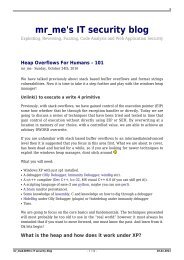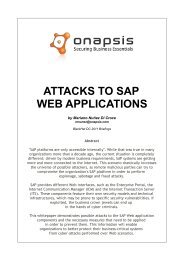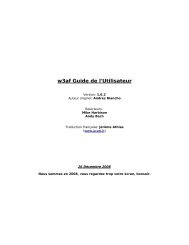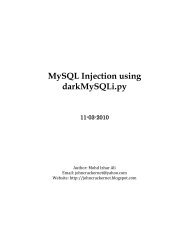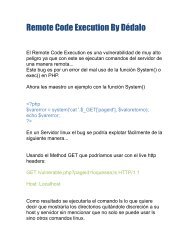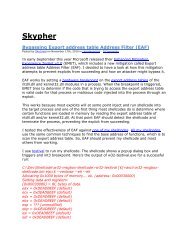Hacking the Skiddies
Hacking the Skiddies
Hacking the Skiddies
Create successful ePaper yourself
Turn your PDF publications into a flip-book with our unique Google optimized e-Paper software.
<strong>Hacking</strong> <strong>the</strong> <strong>Skiddies</strong><br />
Written by: MaXe - Founder of InterN0T.net<br />
Abstract<br />
To be able to hack <strong>the</strong> script kiddies, One could f.ex. find a security hole aka vulnerability in <strong>the</strong><br />
application used. In this case a browser exploitation pack written in PHP was checked for<br />
vulnerabilities in order to find a potential attack vector.<br />
Due to insufficient sanitizing, a SQL-query could be used to inject HTML which this paper<br />
describes in detail. By releasing this information, some script kiddies may hopefully learn more<br />
and stop <strong>the</strong>ir malicious actions.<br />
Introduction<br />
Eleonore is a browser exploit pack / kit which is used to infect unknowing victims with an<br />
executable file which in most cases is a trojan, keylogger or similar malicious software.<br />
The price for such a pack goes from 700$ to $1500 (and even more) when it has just been released.<br />
The contents of such a package are usually well known exploits and occasionally if <strong>the</strong> script kiddy<br />
is lucky, a 0day exploit or two.<br />
Materials and Methods<br />
Browser Exploit Pack used: Eleonore 1.2 (newest version: 1.3.2)<br />
By auditing all of <strong>the</strong> PHP files with a simple text editor, (in this case SciTE which is crossplatform<br />
compatible) it was possible to detect flaws in <strong>the</strong> code made by <strong>the</strong> original developer.<br />
Auditing in this case means: "To look through code and find vulnerabilities".<br />
Results<br />
Index.php is not sanitizing <strong>the</strong> $ref input properly and may be used to inject HTML code.<br />
Parse_url() returns only <strong>the</strong> host-part which means that our injection will have to be made in <strong>the</strong><br />
host-part of <strong>the</strong> referrer URL which we supply to <strong>the</strong> malicious script.<br />
It may also be possible to conduct Blind SQL Injection attacks if magic_quotes is turned off.<br />
(see Code Reference 1 on <strong>the</strong> next page)<br />
Page 1 of 5
Code Reference 1:<br />
Filename: index.php; Lines: 27 - 35;<br />
@$purl = $_SERVER['HTTP_REFERER'];<br />
$ref=parse_url($purl);<br />
@$ref=$ref['host'];<br />
if (!isset($_GET['spl']))<br />
{<br />
$_GET["spl"] ="1";<br />
$q = mysql_query("insert into statistic (date, ip, os, br, country, refer) values ('".date("Y-m-d<br />
H:i:s", time())."', '".$ip."', '".$os."', '".$br."', '".$country."','".$ref."')");<br />
@mysql_free_result($q);<br />
}<br />
Stat.php is not encoding <strong>the</strong> output correct which may be used to display malicious referrer<br />
information such as HTML code directly on <strong>the</strong> page where <strong>the</strong> referrers are displayed / output.<br />
Code Reference 2:<br />
Filename: stat.php; Lines: 298 - 310;<br />
while ($Row = mysql_fetch_array($r)) {<br />
if ($Row['refer']=="") {<br />
$Row['refer']=" -- ";<br />
}<br />
echo "";<br />
echo "".$Row['refer']."";<br />
echo "".$Row['total']."";<br />
echo "".$Row['good']."";<br />
echo "<br />
".round($Row['good']/$Row['total']*100, 2)." %";<br />
}<br />
echo "";<br />
}// ---REFERER!<br />
Proof of Concept:<br />
In order to inject data properly, slash ( / ) must be avoided and so should extreme long strings.<br />
Example Referrer<br />
http://youfail..org<br />
The referrer can be divided into 6 sections. ( [1] defines part 1 while [2] defines part 2 etc.)<br />
Start of hostname: http://youfail.<br />
Use a tag to load JS without using slashes: .org/<br />
(see next page for a visualisation)<br />
Page 2 of 5
This specific injection results in <strong>the</strong> following page: (FireFox only due to atob() is used!)<br />
Normally, <strong>the</strong> referrer page in Eleonore would look like: (resized image)<br />
Page 3 of 5
Since <strong>the</strong> attacking site will only execute once to a user visiting a site with <strong>the</strong> malicious script<br />
injected (usually in an iframe on <strong>the</strong> target site), an attacker may have to use f.ex. an addon in<br />
FireFox known as RefControl. This addon is able to change (spoof) your referrer permanently.<br />
How to setup RefControl:<br />
1. Double-click <strong>the</strong> icon on statusbar.<br />
2. Click "Edit" for "Default for sites not listed".<br />
3. Switch to "Custom" and enter your injection, ex:<br />
http://youfail..org/<br />
(4). Select "3rd Party Requests only". (this function was not tested)<br />
If number 4 is chosen <strong>the</strong>n <strong>the</strong> injection should only happen when a 3rd party site is requested.<br />
In this case it should happen when an iframe is injected to a site that you are visiting so that<br />
<strong>the</strong> malicious site containing <strong>the</strong> browser exploitation kit will automaticly be attacked by you.<br />
Keep in mind that this addon with this setting may compromise o<strong>the</strong>r poorly coded sites.<br />
Discussion<br />
The proof of concept in this paper is a simple defacement of <strong>the</strong> referrer page to show <strong>the</strong><br />
script kiddy that he or she should be aware that <strong>the</strong>re are real hackers out <strong>the</strong>re that may<br />
take actions against such malicious activity.<br />
This method is called: "Blind Defacements" since it is only <strong>the</strong> users with access to <strong>the</strong><br />
statistics page which will be able to see <strong>the</strong> defacement.<br />
Instead of defacing <strong>the</strong> referrer page, injecting a "legit" domain and perhaps an iframe that<br />
points to ano<strong>the</strong>r hackers browser exploitation kit could be an alternative. If One should be<br />
able to succeed in this matter <strong>the</strong>n 0days would of course be preferred.<br />
It is also possible to hijack <strong>the</strong> PHP-session however it would probably require <strong>the</strong> attacker to<br />
check <strong>the</strong> log all <strong>the</strong> time. To "bypass" this issue One could use <strong>the</strong> mail() function in PHP<br />
to send <strong>the</strong> session via e-mail as soon as <strong>the</strong> attacker logs into <strong>the</strong> statistics panel.<br />
The information <strong>the</strong> attacker could obtain from this panel, could be used to lay down <strong>the</strong> botnet<br />
that <strong>the</strong> script kiddy controls or at least notify <strong>the</strong> ISP's that <strong>the</strong> following individuals have been<br />
infected with malware that may be used to conduct spam or DDoS attacks.<br />
Acknowledgements<br />
Many thanks to KrebsonSecurity for enlighting me about this browser exploitation pack and of<br />
course <strong>the</strong> person that leaked it to <strong>the</strong> public so I wouldn't have to pay <strong>the</strong> outrageous $700 to<br />
$1500 amount of money for one of <strong>the</strong> less good browser exploitation packs.<br />
Thanks to "highjack" and <strong>the</strong> community of InterN0T for giving me ideas when needed.<br />
Page 4 of 5
References:<br />
RefControl: https://addons.mozilla.org/da/firefox/addon/953<br />
KrebsonSecurity: http://www.krebsonsecurity.com/2010/01/a-peek-inside-<strong>the</strong>-eleonorebrowser-exploit-kit/<br />
InterN0T: http://www.intern0t.net/<br />
Download: http://d01.megashares.com/d01=a286e8e (See Notes Below!)<br />
File => dx_ds.gif was detected as => Downloader.Fostrem (malware)<br />
Info: http://securityresponse.symantec.com/security_response/writeup.jsp<br />
docid=2009-070605-3347-99<br />
Page 5 of 5



